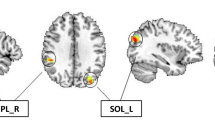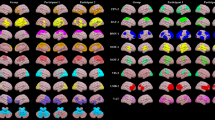Abstract
The current study aimed to explore the behavioral, daily-life executive functional, and brain functional connectivity patterns in children with attention-deficit/hyperactivity disorder (ADHD) and anxiety. A total of 246 children with non-comorbid ADHD and 91 healthy controls (HCs) participated in the current study, among whom 175 subjects went through resting-state functional magnetic resonance imaging (fMRI) scans. The ADHD participants were divided into two subgroups: ADHD with a high level of anxiety (ADHD + ANX) and ADHD with a low level of anxiety (ADHD-ANX). The Child Behavior Checklist (CBCL) and the Behavior Rating Inventory of Executive Function (BRIEF) were used to capture the behavioral and daily-life executive functional characteristics. Independent component analysis with dual regression models was applied to the fMRI data. All statistical models were estimated with age and sex as covariates. Compared with the ADHD-ANX group, the ADHD + ANX group showed more withdrawn, somatic, social, thought, attention, delinquent, and aggressive problems (all corrected p < 0.05). The ADHD + ANX group also displayed more impaired emotional control and working memory than the ADHD-ANX (all corrected p < 0.05). The ADHD-ANX group, but not the ADHD + ANX group, showed elevated functional connectivity within the default mode network compared with the HC group. The mean function connectivity within the default mode network significantly mediated the correlation between anxiety level and attention problems. In sum, anxiety in children with ADHD was associated with more social, emotional, and behavioral problems, more impaired daily-life executive function, and altered brain function. Our work provides important information on the heterogeneity of ADHD.


Similar content being viewed by others
Data Availability
Not applicable.
Change history
21 October 2022
A Correction to this paper has been published: https://doi.org/10.1007/s11682-022-00730-w
Abbreviations
- ADHD:
-
attention-deficit/hyperactivity disorder.
- ANX:
-
anxiety.
References
Adamo, N., Michelini, G., Cheung, C. H. M., Buitelaar, J. K., Asherson, P., Rijsdijk, F., & Kuntsi, J. (2021). Does Co-Occurring Anxiety Modulate ADHD-Related Cognitive and Neurophysiological Impairments? Journal Of Attention Disorders, 25(8), 1135–1145. https://doi.org/10.1177/1087054719879499
American Psychiatric Association. (2013). Diagnostic and statistical manual of mental disorders (5th ed.).). American Psychiatric Association. https://doi.org/10.1176/appi.books.9780890425596
Basten, U., Stelzel, C., & Fiebach, C. J. (2011). Trait anxiety modulates the neural efficiency of inhibitory control. Journal Of Cognitive Neuroscience, 23(10), 3132–3145. https://doi.org/10.1162/jocn_a_00003
Becker, S. P., Luebbe, A. M., Stoppelbein, L., Greening, L., & Fite, P. J. (2012). Aggression among children with ADHD, anxiety, or co-occurring symptoms: competing exacerbation and attenuation hypotheses. Journal Of Abnormal Child Psychology, 40(4), 527–542. https://doi.org/10.1007/s10802-011-9590-7
Bilgic, A., Tufan, A. E., Yilmaz, S., Ozcan, O., Ozmen, S., Oztop, D., Turkoglu, S., Akca, O. F., Yar, A., Isik, U., Sivri, C., Polat, R., Irmak, H., Donmez, A., Bayhan, Y. E. C., Ucur, P., Cansiz, O., M. A., & Savci, U. (2017). Association of Reactive-Proactive Aggression and Anxiety Sensitivity with Internalizing and Externalizing Symptoms in Children with Attention-Deficit/Hyperactivity Disorder. Child Psychiatry And Human Development, 48(2), 283–297. https://doi.org/10.1007/s10578-016-0640-9
Bishop, C., Mulraney, M., Rinehart, N., & Sciberras, E. (2019). An examination of the association between anxiety and social functioning in youth with ADHD: A systematic review. Psychiatry Research, 273, 402–421. https://doi.org/10.1016/j.psychres.2019.01.039
Brown, T. E. (2008). ADD/ADHD and Impaired Executive Function in Clinical Practice. Curr Psychiatry Rep, 10(5), 407–411. https://doi.org/10.1007/s11920-008-0065-7
Cortese, S., Kelly, C., Chabernaud, C., Proal, E., Di Martino, A., Milham, M. P., & Castellanos, F. X. (2012). Toward systems neuroscience of ADHD: a meta-analysis of 55 fMRI studies. American Journal Of Psychiatry, 169(10), 1038–1055. https://doi.org/10.1176/appi.ajp.2012.11101521
Eklund, A., Nichols, T. E., & Knutsson, H. (2016). Cluster failure: Why fMRI inferences for spatial extent have inflated false-positive rates. Proc Natl Acad Sci U S A, 113(28), 7900–7905. https://doi.org/10.1073/pnas.1602413113
Ergul, C., Ulasoglu-Yildiz, C., Kurt, E., Koyuncu, A., Kicik, A., Demiralp, T., & Tukel, R. (2019). Intrinsic functional connectivity in social anxiety disorder with and without comorbid attention deficit hyperactivity disorder. Brain Research, 1722, 146364. https://doi.org/10.1016/j.brainres.2019.146364
Falk, A. E., Lee, S. S., & Chorpita, B. F. (2017). Differential Association of Youth Attention-Deficit/Hyperactivity Disorder and Anxiety With Delinquency and Aggression. Journal Of Clinical Child And Adolescent Psychology : The Official Journal For The Society Of Clinical Child And Adolescent Psychology, American Psychological Association, Division 53, 46(5), 653–660. https://doi.org/10.1080/15374416.2015.1055858
Faraone, S. V., Asherson, P., Banaschewski, T., Biederman, J., Buitelaar, J. K., Ramos-Quiroga, J. A., Rohde, L. A., Sonuga-Barke, E. J., Tannock, R., & Franke, B. (2015). Attention-deficit/hyperactivity disorder. Nat Rev Dis Primers, 1, 15020. https://doi.org/10.1038/nrdp.2015.20
Faraone, S. V., Rostain, A. L., Blader, J., Busch, B., Childress, A. C., Connor, D. F., & Newcorn, J. H. (2019). Practitioner Review: Emotional dysregulation in attention-deficit/hyperactivity disorder - implications for clinical recognition and intervention. Journal Of Child Psychology And Psychiatry, 60(2), 133–150. https://doi.org/10.1111/jcpp.12899
Gao, Y., Shuai, D., Bu, X., Hu, X., Tang, S., Zhang, L., Li, H., Hu, X., Lu, L., Gong, Q., & Huang, X. (2019). Impairments of large-scale functional networks in attention-deficit/hyperactivity disorder: a meta-analysis of resting-state functional connectivity. Psychological Medicine, 49(15), 2475–2485. https://doi.org/10.1017/S003329171900237X
Gioia, G. A., Isquith, P. K., Kenworthy, L., & Barton, R. M. (2002). Profiles of everyday executive function in acquired and developmental disorders. Child Neuropsychology, 8(2), 121–137. https://doi.org/10.1076/chin.8.2.121.8727
Humphreys, K. L., Aguirre, V. P., & Lee, S. S. (2012). Association of anxiety and ODD/CD in children with and without ADHD. Journal Of Clinical Child And Adolescent Psychology : The Official Journal For The Society Of Clinical Child And Adolescent Psychology, American Psychological Association, Division 53, 41(3), 370–377. https://doi.org/10.1080/15374416.2012.656557
Jarrett, M. A. (2016). Attention-deficit/hyperactivity disorder (ADHD) symptoms, anxiety symptoms, and executive functioning in emerging adults. Psychological Assessment, 28(2), 245–250. https://doi.org/10.1037/pas0000190
Kertz, S. J., Belden, A. C., Tillman, R., & Luby, J. (2016). Cognitive Control Deficits in Shifting and Inhibition in Preschool Age Children are Associated with Increased Depression and Anxiety Over 7.5 Years of Development. Journal Of Abnormal Child Psychology, 44(6), 1185–1196. https://doi.org/10.1007/s10802-015-0101-0
Lai, C. H. (2020). Task MRI-Based Functional Brain Network of Anxiety. Advances In Experimental Medicine And Biology, 1191, 3–20. https://doi.org/10.1007/978-981-32-9705-0_1
Liu, T. L., Yang, P., Ko, C. H., Yen, J. Y., & Yen, C. F. (2014). Association between ADHD symptoms and anxiety symptoms in Taiwanese adolescents. Journal Of Attention Disorders, 18(5), 447–455. https://doi.org/10.1177/1087054712439936
Nickerson, L. D., Smith, S. M., Ongur, D., & Beckmann, C. F. (2017). Using Dual Regression to Investigate Network Shape and Amplitude in Functional Connectivity Analyses. Front Neurosci, 11, 115. https://doi.org/10.3389/fnins.2017.00115
Noble, S., Scheinost, D., & Constable, R. T. (2020). Cluster failure or power failure? Evaluating sensitivity in cluster-level inference. Neuroimage, 209, 116468. https://doi.org/10.1016/j.neuroimage.2019.116468
O’Rourke, S. R., Bray, A. C., & Anastopoulos, A. D. (2020). Anxiety Symptoms and Disorders in College Students With ADHD. Journal Of Attention Disorders, 24(12), 1764–1774. https://doi.org/10.1177/1087054716685837
Quintero, J., Morales, I., Vera, R., Zuluaga, P., & Fernandez, A. (2019). The Impact of Adult ADHD in the Quality of Life Profile. Journal Of Attention Disorders, 23(9), 1007–1016. https://doi.org/10.1177/1087054717733046
Ruf, B. M., Bessette, K. L., Pearlson, G. D., & Stevens, M. C. (2017). Effect of trait anxiety on cognitive test performance in adolescents with and without attention-deficit/hyperactivity disorder. Journal Of Clinical And Experimental Neuropsychology, 39(5), 434–448. https://doi.org/10.1080/13803395.2016.1232373
Sorensen, L., Plessen, K. J., Nicholas, J., & Lundervold, A. J. (2011). Is behavioral regulation in children with ADHD aggravated by comorbid anxiety disorder? Journal Of Attention Disorders, 15(1), 56–66. https://doi.org/10.1177/1087054709356931
Sorensen, L., Eichele, T., van Wageningen, H., Plessen, K. J., & Stevens, M. C. (2016). Amplitude variability over trials in hemodynamic responses in adolescents with ADHD: The role of the anterior default mode network and the non-specific role of the striatum. Neuroimage Clin, 12, 397–404. https://doi.org/10.1016/j.nicl.2016.08.007
Sutcubasi, B., Metin, B., Kurban, M. K., Metin, Z. E., Beser, B., & Sonuga-Barke, E. (2020). Resting-state network dysconnectivity in ADHD: A system-neuroscience-based meta-analysis. The World Journal Of Biological Psychiatry : The Official Journal Of The World Federation Of Societies Of Biological Psychiatry, 21(9), 662–672. https://doi.org/10.1080/15622975.2020.1775889
Tseng, W. L., & Gau, S. S. (2013). Executive function as a mediator in the link between attention-deficit/hyperactivity disorder and social problems. Journal Of Child Psychology And Psychiatry, 54(9), 996–1004. https://doi.org/10.1111/jcpp.12072
Wan, B., Wang, Z., Jung, M., Lu, Y., He, H., Chen, Q., & Jin, Y. (2019). Effects of the Co-occurrence of Anxiety and Attention-Deficit/Hyperactivity Disorder on Intrinsic Functional Network Centrality among Children with Autism Spectrum Disorder. Autism Research, 12(7), 1057–1068. https://doi.org/10.1002/aur.2120
Wang, T., Liu, K., Li, Z., Xu, Y., Liu, Y., Shi, W., & Chen, L. (2017). Prevalence of attention deficit/hyperactivity disorder among children and adolescents in China: a systematic review and meta-analysis. Bmc Psychiatry, 17(1), 32. https://doi.org/10.1186/s12888-016-1187-9
Funding
The author(s) disclosed receipt of the following financial support for the research, authorship, and/or publication of this article: This work was supported by the Sanming Project of Medicine in Shenzhen “The ADHD research group from Peking University Sixth Hospital” (SZSM201612036), the Basic and Applied Basic Research Project of Guangdong Province of China (2019A1515110700 to Zhao-Min Wu), and the National Natural Science Foundation of China (82071537, 82101613).
Author information
Authors and Affiliations
Contributions
Zhao-Min Wu and Peng Wang contributed significantly to the data collection, data analysis, and manuscript preparation. Juan Liu and Xiao-Lan Cao helped conduct the study. Lu Liu, Sun Li, and Qing-Jiu Cao helped with the data analysis, as well as the writing and reviewing of the manuscript. Li Yang, Bin-Rang Yang, and Yu-Feng Wang contributed to the design of the study, the data analysis, and the manuscript preparation.
Corresponding authors
Ethics declarations
Conflict of interest
Zhao-Min Wu, Peng Wang, Juan Liu, Lu Liu, Xiao-Lan Cao, Li Sun, Qing-Jiu Cao, Li Yang, Yu-Feng Wang, and Bin-Rang Yang do not have any conflicts of interest.
Compliance with ethical standards
This work was approved by the Ethics Committee of Shenzhen Children’s Hospital (identification number: 202005702). Informed consent was obtained from parents of children prior to the study.
Additional information
Publisher’s Note
Springer Nature remains neutral with regard to jurisdictional claims in published maps and institutional affiliations.
The original online version of this article was revised: The certificate of English Editing has been included as one of the supplementary files, which should not be included in the publication.
Electronic supplementary material
Below is the link to the electronic supplementary material.
Rights and permissions
Springer Nature or its licensor holds exclusive rights to this article under a publishing agreement with the author(s) or other rightsholder(s); author self-archiving of the accepted manuscript version of this article is solely governed by the terms of such publishing agreement and applicable law.
About this article
Cite this article
Wu, ZM., Wang, P., Liu, J. et al. Behavioral and brain functional characteristics of children with Attention-Deficit/Hyperactivity disorder and anxiety trait. Brain Imaging and Behavior 16, 2657–2665 (2022). https://doi.org/10.1007/s11682-022-00722-w
Received:
Revised:
Accepted:
Published:
Issue Date:
DOI: https://doi.org/10.1007/s11682-022-00722-w




